Effect of Replacing Fine Aggregate with Fly Ash on the Performance of Mortar
Abstract
1. Introduction
2. Test Plan
2.1. Raw Materials
2.2. Mix Ratio
2.3. Sample Preparation
2.4. Test Methods
2.4.1. Compressive Strength and Flexural Strength
2.4.2. Ultrasonic Pulse Velocity
2.4.3. Drying Shrinkage
2.4.4. High Temperature Experiment and Loading Method
3. Results and Discussion
3.1. Compressive Strength
3.2. Flexural Strength
3.3. Relationship between the Compressive Strength and Flexural Strength of Mortar
3.4. Ultrasonic Pulse Velocity
3.5. Drying Shrinkage
3.6. Formatting of Mathematical Components
4. Conclusions
- With increasing fly ash content, the strength of the fly ash fine aggregate mortar first increased and then decreased. When the fly ash content was 80%, the mortar strength reached its maximum, with a compressive strength of 62.93 MPa and a flexural strength of 12.47 MPa at 90 d, which were 23.56% and 14.72% higher than those of the ordinary mortar, respectively. This indicates that fly ash can be used as a fine aggregate to prepare green building mortar with mechanical properties that meet application requirements and have good engineering application values.
- The correlation between the compressive and flexural strengths of the fly ash fine aggregate mortar was corrected by comparing the specifications for different regions. The revised correlation model between the compressive and flexural strengths was more accurate. In addition, the variation trends of the ultrasonic pulse wave velocity and flexural compressive strength were the same, with a maximum of 4.23 km/s reached when the fly ash content was 80%.
- The results of the drying shrinkage test indicated that the higher the amount of fly ash replacing the fine aggregate, the smaller the drying shrinkage strain of the mortar. The addition of fly ash significantly affected the 90 d drying shrinkage rate. At the 100% substitution level, the drying shrinkage property of the mortar reached its optimal level, and the drying shrinkage rate was reduced by 29.01% compared to that of ordinary mortar. The drying shrinkage results also indicated that fly ash inhibited the drying shrinkage of the mortar.
- The high-temperature test results indicated that using fly ash as a substitute for natural river sand can improve the high-temperature resistance of mortars. Mortars containing 80% fly ash as a substitute for natural river sand had a higher residual compressive strength than the other mortars. In addition, the addition of fly ash did not significantly affect the quality loss of the mortar at high temperatures.
Author Contributions
Funding
Institutional Review Board Statement
Informed Consent Statement
Data Availability Statement
Conflicts of Interest
References
- Ren, Z.; Jiang, M.; Chen, D.; Yu, Y.; Li, F.; Xu, M.; Bringezu, S.; Zhu, B. Stocks and flows of sand, gravel, and crushed stone in China (1978–2018): Evidence of the peaking and structural transformation of supply and demand. Resour. Conserv. Recycl. 2022, 180, 106173. [Google Scholar] [CrossRef]
- Rentier, E.S.; Cammeraat, L.H. The environmental impacts of river sand mining. Sci. Total Environ. 2022, 838 Pt 1, 155877. [Google Scholar] [CrossRef]
- Shi, J.; Tan, J.; Liu, B.; Chen, J.; Dai, J.; He, Z. Experimental study on full-volume slag alkali-activated mortars: Air-cooled blast furnace slag versus machine-made sand as fine aggregates. J. Hazard. Mater. 2021, 403, 123983. [Google Scholar] [CrossRef]
- Santhosh, K.G.; Subhani, S.M.; Bahurudeen, A. Cleaner production of concrete by using industrial by-products as fine aggregate: A sustainable solution to excessive river sand mining. J. Build. Eng. 2021, 42, 102415. [Google Scholar] [CrossRef]
- Xiao, J.; Qiang, C.; Nanni, A.; Zhang, K. Use of sea-sand and seawater in concrete construction: Current status and future opportunities. Constr. Build. Mater. 2017, 155, 1101–1111. [Google Scholar] [CrossRef]
- Li, H.; Huang, F.; Cheng, G.; Xie, Y.; Tan, Y.; Li, L.; Yi, Z. Effect of granite dust on mechanical and some durability properties of manufactured sand concrete. Constr. Build. Mater. 2016, 109, 41–46. [Google Scholar] [CrossRef]
- Dong, Z.; Wu, G.; Xu, Y. Experimental study on the bond durability between steel-FRP composite bars (SFCBs) and sea sand concrete in ocean environment. Constr. Build. Mater. 2016, 115, 277–284. [Google Scholar] [CrossRef]
- He, X.; Zhou, J. Mechanical characteristics of sea-sand concrete in simulated marine environment. Constr. Build. Mater. 2021, 274, 122098. [Google Scholar] [CrossRef]
- Dong, B.; Chen, C.; Wei, G.; Fang, G.; Wu, K.; Wang, Y. Fly ash-based artificial aggregates synthesized through alkali-activated cold-bonded pelletization technology. Constr. Build. Mater. 2022, 344, 128268. [Google Scholar] [CrossRef]
- Shi, Y.; Jing, H.; Liu, B.; Hou, C.; Qian, H. Synergistic utilization of porous coral sand and fly ash for multifunctional engineered cementitious composites with polyethylene fibers: Intensified electromagnetic wave absorption and mechanism. J. Clean. Prod. 2023, 396, 136497. [Google Scholar] [CrossRef]
- Khankhaje, E.; Kim, T.; Jang, H.; Kim, C.-S.; Kim, J.; Rafieizonooz, M. Properties of pervious concrete incorporating fly ash as partial replacement of cement: A review. Dev. Built Environ. 2023, 14, 100130. [Google Scholar] [CrossRef]
- Ozturk, M.; Karaaslan, M.; Akgol, O.; Sevim, U.K. Mechanical and electromagnetic performance of cement based composites containing different replacement levels of ground granulated blast furnace slag, fly ash, silica fume and rice husk ash. Cem. Concr. Res. 2020, 136, 106177. [Google Scholar] [CrossRef]
- Liu, B.; Shi, J.; Liang, H.; Jiang, J.; Yang, Y.; He, Z. Synergistic enhancement of mechanical property of the high replacement low-calcium ultrafine fly ash blended cement paste by multiple chemical activators. J. Build. Eng. 2020, 32, 101520. [Google Scholar] [CrossRef]
- Bendapudi, S.C.K. Contribution of Fly ash to the properties of Mortar and Concrete. Int. J. Earth Sci. Eng. 2011, 4, 1017–1023. [Google Scholar]
- Wang, W.; Lu, C.; Li, Y.; Yuan, G.; Li, Q. Effects of stress and high temperature on the carbonation resistance of fly ash concrete. Constr. Build. Mater. 2017, 138, 486–495. [Google Scholar] [CrossRef]
- Zhao, Y.; Hu, X.; Shi, C.; Zhang, Z.; Zhu, D. A review on seawater sea-sand concrete: Mixture proportion, hydration, microstructure and properties. Constr. Build. Mater. 2021, 295, 123602. [Google Scholar] [CrossRef]
- Du, S.; Jiang, Y.; Zhong, J.; Ge, Y.; Shi, X. Surface abrasion resistance of high-volume fly ash concrete modified by graphene oxide: Macro- and micro-perspectives. Constr. Build. Mater. 2020, 237, 117686. [Google Scholar] [CrossRef]
- Seo, T.; Lee, M.; Choi, C.; Ohno, Y. Properties of drying shrinkage cracking of concrete containing fly ash as partial replacement of fine aggregate. Mag. Concr. Res. 2010, 62, 427–433. [Google Scholar] [CrossRef]
- Zhang, D.; Mao, M.; Zhang, S.; Yang, Q. Influence of stress damage and high temperature on the freeze–thaw resistance of concrete with fly ash as fine aggregate. Constr. Build. Mater. 2019, 229, 116845. [Google Scholar] [CrossRef]
- Yin, S.; Yan, Z.; Chen, X.; Wang, L. Effect of fly-ash as fine aggregate on the workability and mechanical properties of cemented paste backfill. Case Stud. Constr. Mater. 2022, 16, e01039. [Google Scholar] [CrossRef]
- Siddique, R. Effect of fine aggregate replacement with Class F fly ash on the mechanical properties of concrete. Cem. Concr. Res. 2003, 33, 539–547. [Google Scholar] [CrossRef]
- Mao, M.; Ai, Q.; Zhang, D.; Li, S.; Li, J.; Černý, R. Durability Performance of Concrete with Fly Ash as Fine Aggregate Eroded by Chloride Salt. Adv. Mater. Sci. Eng. 2022, 2022, 6760385. [Google Scholar] [CrossRef]
- Ishimaru, K. Properties of Concrete Using Copper Slag and Second Class Fly Ash as a Part of Fine Aggregate. J. Soc. Mat. Sci. Jpn. 2005, 54, 828–833. [Google Scholar] [CrossRef]
- Bilir, T.; Gencel, O.; Topcu, I.B. Properties of mortars with fly ash as fine aggregate. Constr. Build. Mater. 2015, 93, 782–789. [Google Scholar] [CrossRef]
- GB/T 1596-2017; Fly Ash Used for Cement and Concrete. China Standards Press: Beijing, China, 2018.
- Suraneni, P.; Burris, L.; Shearer, C.R.; Hooton, R.D. ASTM C618 Fly Ash Specification: Comparison with Other Specifications, Shortcomings, and Solutions. ACI Mater. J. 2021, 118, 157–167. [Google Scholar]
- GB/T 17671-2021; Test Method of Cement Mortar Strength (ISO Method). China Standards Press: Beijing, China, 2021.
- ASTM C 597; Standard Specification for Pulse Velocity through Concrete. Concrete Institute: Farmington Hills, MI, USA, 2009.
- GB/T 29417-2012; Standard Test Methods for Drying Shrinkage Stress and Cracking Possibility of Cement Mortar and Concrete. China Standards Press: Beijing, China, 2012.
- Yang, S.; Wi, S.; Lee, J.; Lee, H.; Kim, S. Biochar-red clay composites for energy efficiency as eco-friendly building materials: Thermal and mechanical performance. J. Hazard. Mater. 2019, 373, 844–855. [Google Scholar] [CrossRef]
- Liu, C.; Yang, L.; Li, Z.; Nie, S.; Hu, C.; Wang, F. Improve the long-term property of heat-cured mortars blended with fly ash by internal curing. J. Build. Eng. 2022, 54, 104624. [Google Scholar] [CrossRef]
- Liu, J.; Wang, Y. Predicting the chloride diffusion in concrete incorporating fly ash by a multi-scale model. J. Clean. Prod. 2022, 330, 129767. [Google Scholar] [CrossRef]
- da Silva, A.M.; de Brito, J.; Veiga, R. Incorporation of fine plastic aggregates in rendering mortars. Constr. Build. Mater. 2014, 71, 226–236. [Google Scholar] [CrossRef]
- Wang, Y.; Wu, J.; Ma, D.; Pu, H.; Yin, Q.; Chen, W. Study on macro-meso mechanical properties of cemented tailings backfill with high fly ash content. Environ. Sci. Pollut. Res. Int. 2023, 30, 2904–2917. [Google Scholar] [CrossRef]
- Sun, J.; Zhang, Z.; Hou, G. Utilization of fly ash microsphere powder as a mineral admixture of cement: Effects on early hydration and microstructure at different curing temperatures. Powder Technol. 2020, 375, 262–270. [Google Scholar] [CrossRef]
- Indian Standard. 456-2000; Plain and Reinforced Concrete–Code of Practice. Bureau of Indian Standards: New Delhi, Indian, 2000.
- Chihaoui, R.; Siad, H.; Senhadji, Y.; Mouli, M.; Nefoussi, A.M.; Lachemi, M. Efficiency of natural pozzolan and natural perlite in controlling the alkali-silica reaction of cementitious materials. Case Stud. Constr. Mater. 2022, 17, e01246. [Google Scholar] [CrossRef]
- Liu, X.; Liu, L.; Lyu, K.; Li, T.; Zhao, P.; Liu, R.; Zuo, J.; Fu, F.; Shah, S.P. Enhanced early hydration and mechanical properties of cement-based materials with recycled concrete powder modified by nano-silica. J. Build. Eng. 2022, 50, 104175. [Google Scholar] [CrossRef]
- Liu, C.; Huang, X.; Wu, Y.-Y.; Deng, X.; Zheng, Z. The effect of graphene oxide on the mechanical properties, impermeability and corrosion resistance of cement mortar containing mineral admixtures. Constr. Build. Mater. 2021, 288, 123059. [Google Scholar] [CrossRef]
- Ramaniraka, M.; Rakotonarivo, S.; Payan, C.; Garnier, V. Effect of the Interfacial Transition Zone on ultrasonic wave attenuation and velocity in concrete. Cem. Concr. Res. 2019, 124, 105809. [Google Scholar] [CrossRef]
- Gao, S.; Wang, Z.; Wang, W.; Qiu, H. Effect of shrinkage-reducing admixture and expansive agent on mechanical properties and drying shrinkage of Engineered Cementitious Composite (ECC). Constr. Build. Mater. 2018, 179, 172–185. [Google Scholar] [CrossRef]
- Gupta, S.; Kashani, A.; Mahmood, A.H.; Han, T. Carbon sequestration in cementitious composites using biochar and fly ash—Effect on mechanical and durability properties. Constr. Build. Mater. 2021, 291, 123363. [Google Scholar] [CrossRef]
- Zhang, D.; Han, P.; Yang, Q.; Mao, M. Shrinkage Effects of Using Fly Ash Instead of Fine Aggregate in Concrete Mixtures. Adv. Mater. Sci. Eng. 2020, 2020, 1–11. [Google Scholar] [CrossRef]
- Heikal, M. Effect of temperature on the physico-mechanical and mineralogical properties of Homra pozzolanic cement pastes. Cem. Concr. Res. 2000, 30, 1835–1839. [Google Scholar] [CrossRef]
- Qian, Y.; Yang, D.; Xia, Y.; Gao, H.; Ma, Z. Properties and improvement of ultra-high performance concrete with coarse aggregates and polypropylene fibers after high-temperature damage. Constr. Build. Mater. 2023, 364, 129925. [Google Scholar] [CrossRef]
- Shi, J.; Liu, B.; Chu, S.H.; Zhang, Y.; Zhang, Z.; Han, K. Recycling air-cooled blast furnace slag in fiber reinforced alkali-activated mortar. Powder Technol. 2022, 407, 117686. [Google Scholar] [CrossRef]
- Shen, Y.; Peng, C.; Hao, J.; Bai, Z.; Li, Y.; Yang, B. High temperature resistance of desert sand concrete: Strength change and intrinsic mechanism. Constr. Build. Mater. 2022, 327, 126948. [Google Scholar] [CrossRef]
- Yang, Y.; Liu, Y.; Yan, Z.; Chen, Z. High-Temperature Resistance of Modified Potassium Magnesium Phosphate Cement. Materials 2022, 15, 8967. [Google Scholar] [CrossRef]
- Vaezi, M.; Sedaghatdoost, A.; Norouzifar, M.N.; Madani, H. Petrographic Investigation into the Influence of Chopped Basalt Fibers on the Microstructure of Portland Cement Mortars at Elevated Temperatures. J. Mater. Civ. Eng. 2021, 33, 5. [Google Scholar] [CrossRef]
- Nuaklong, P.; Wongsa, A.; Boonserm, K.; Ngohpok, C.; Jongvivatsakul, P.; Sata, V.; Sukontasukkul, P.; Chindaprasirt, P. Enhancement of mechanical properties of fly ash geopolymer containing fine recycled concrete aggregate with micro carbon fiber. J. Build. Eng. 2021, 41, 102403. [Google Scholar] [CrossRef]
- Zhu, Q.; Yuan, Y.-x.; Chen, J.-h.; Fan, L.; Yang, H. Research on the high-temperature resistance of recycled aggregate concrete with iron tailing sand. Constr. Build. Mater. 2022, 327, 126889. [Google Scholar] [CrossRef]
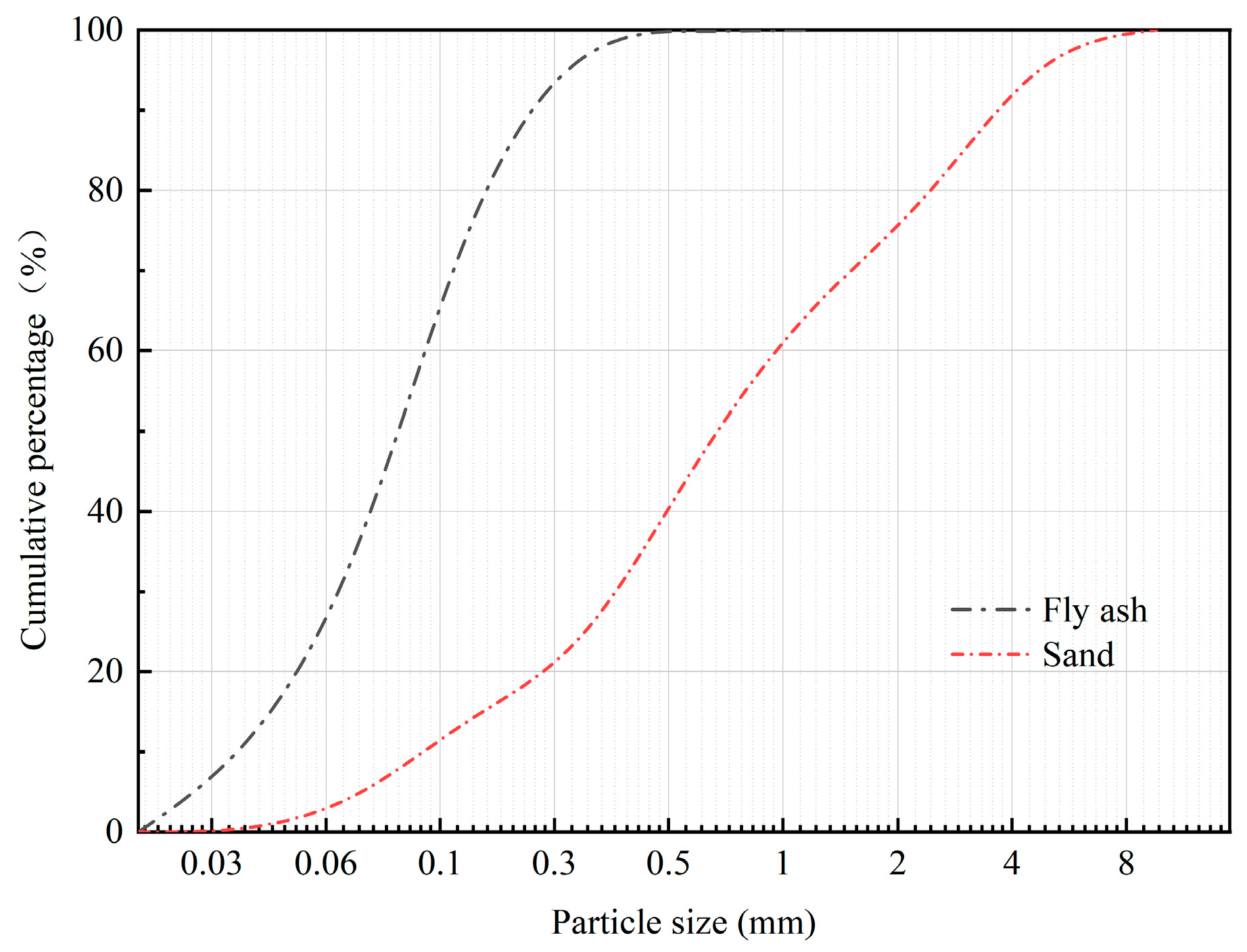

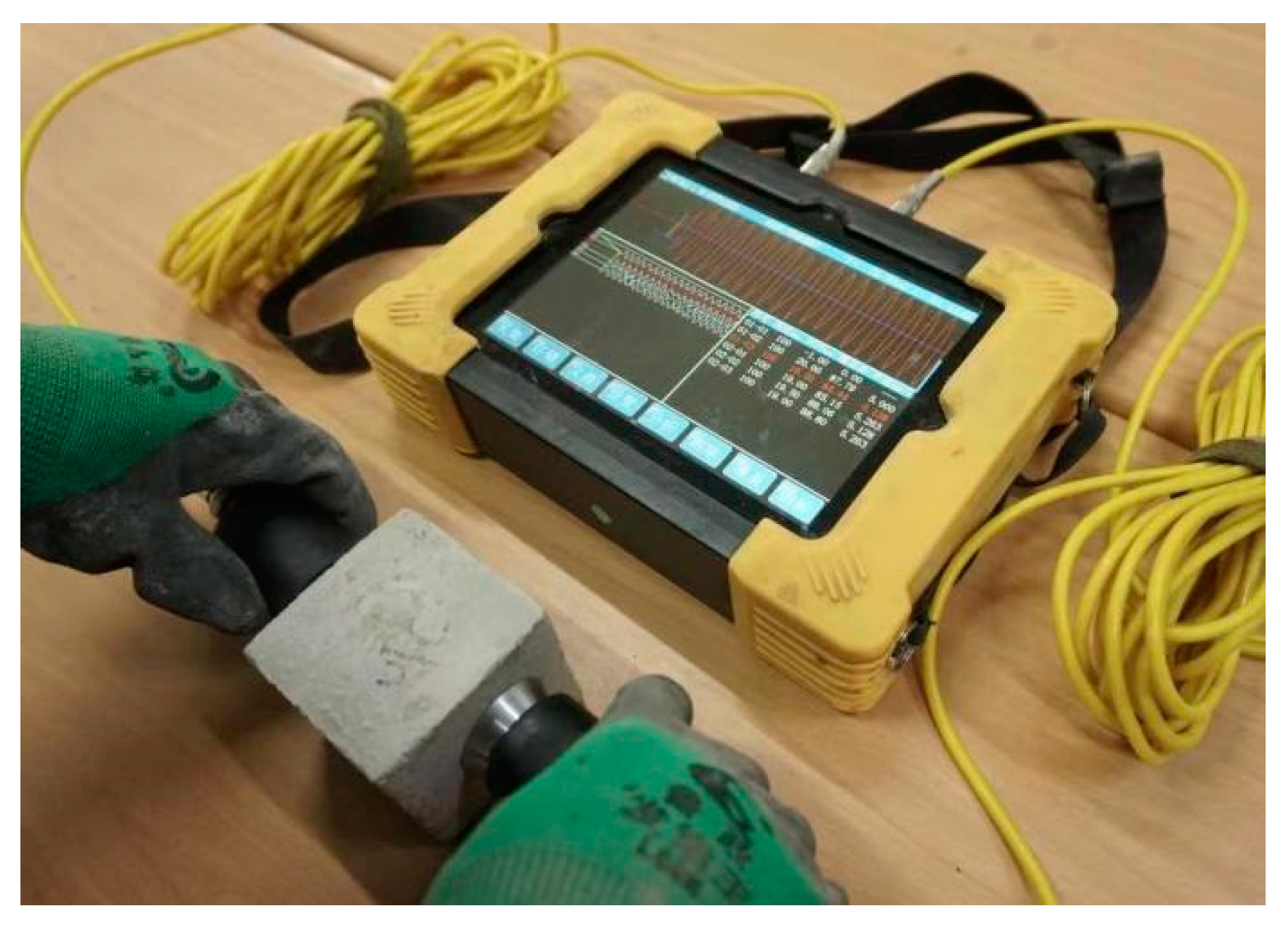
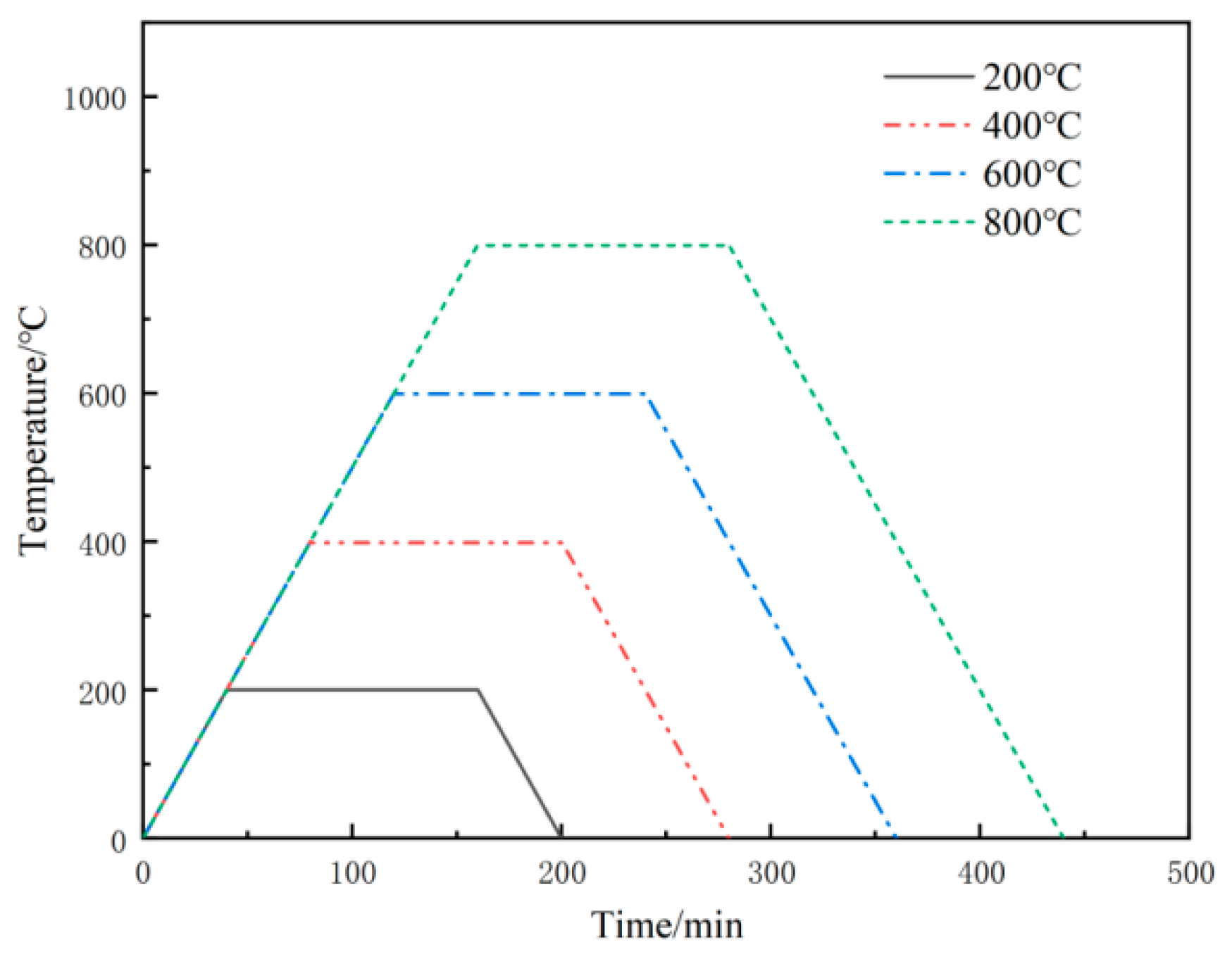
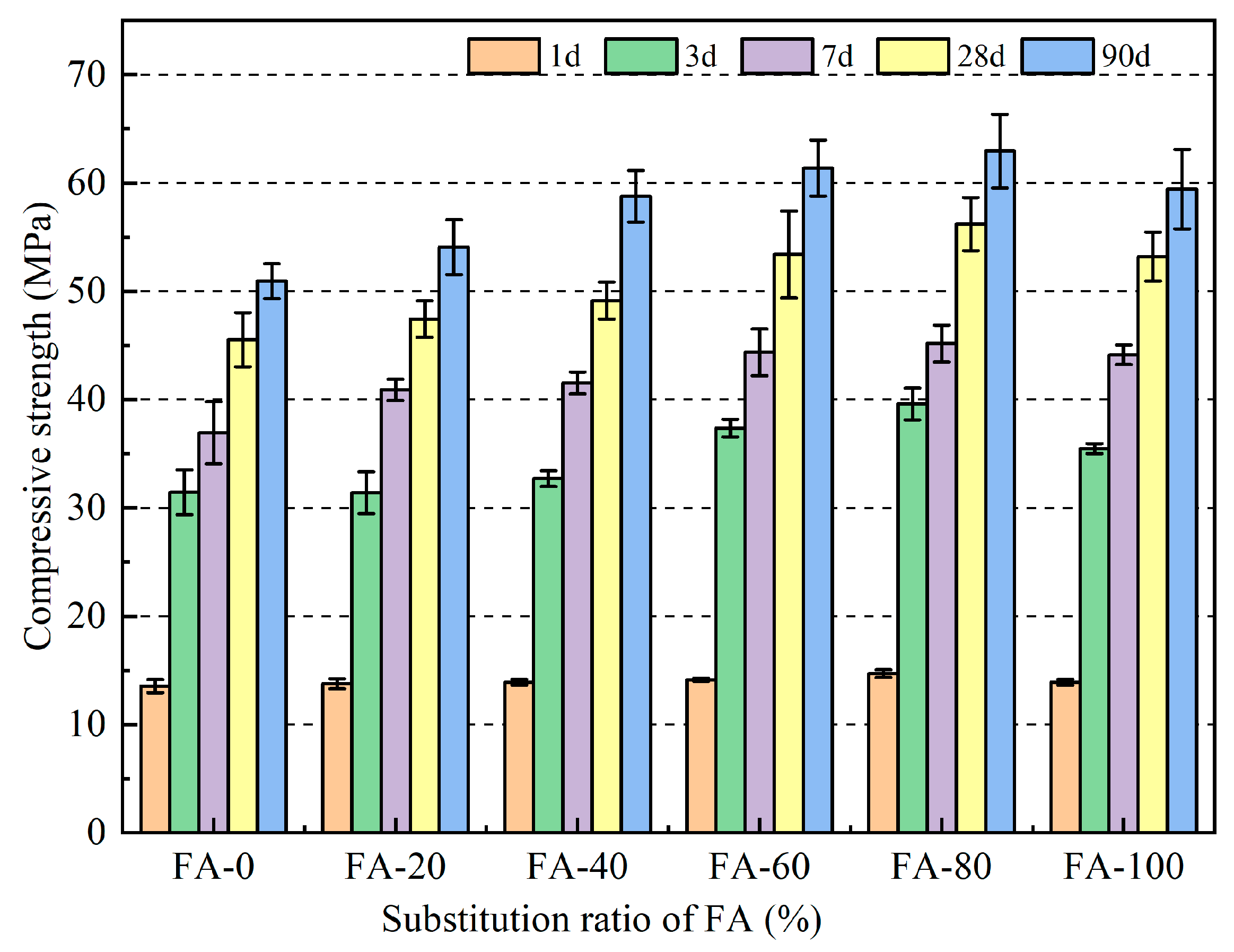
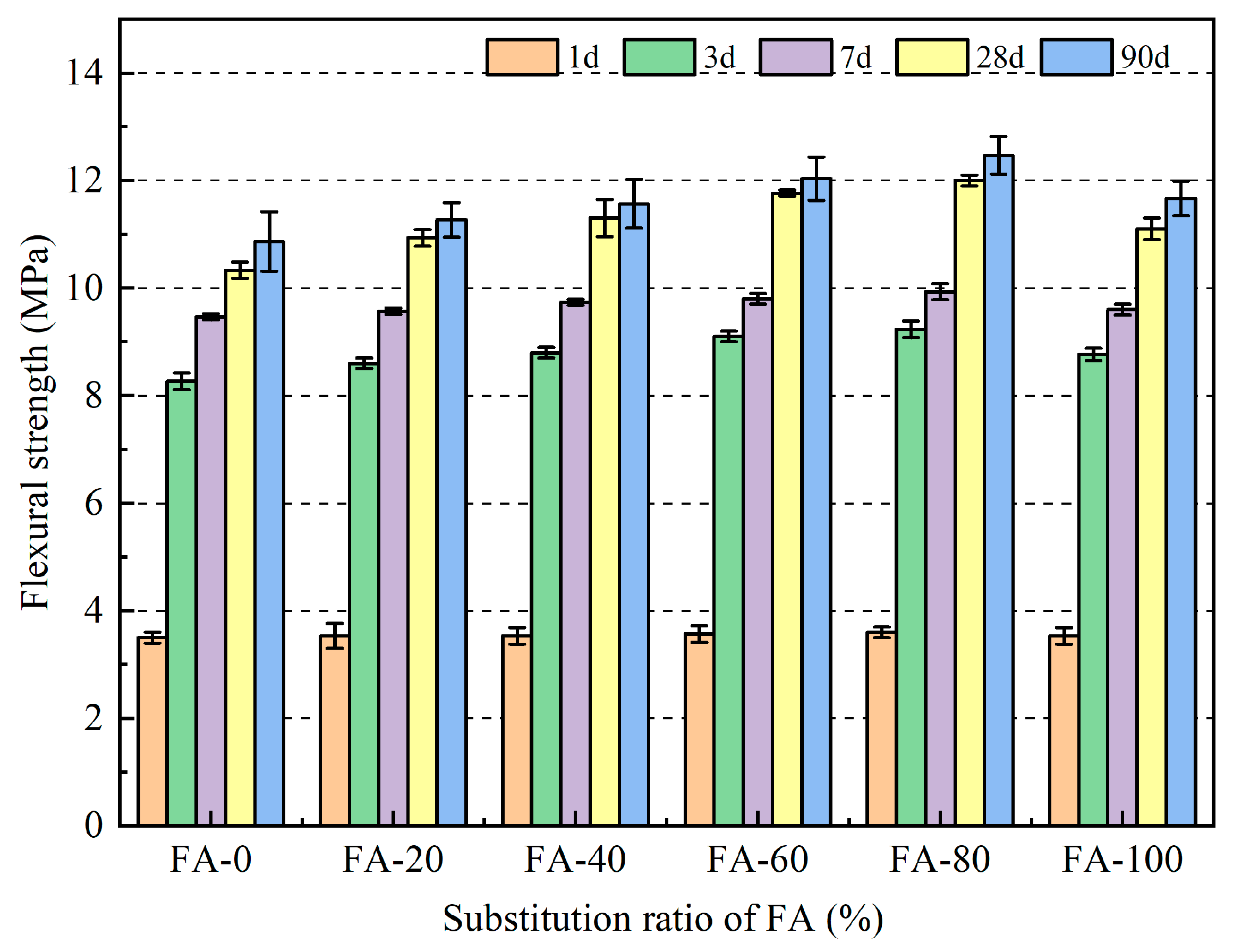
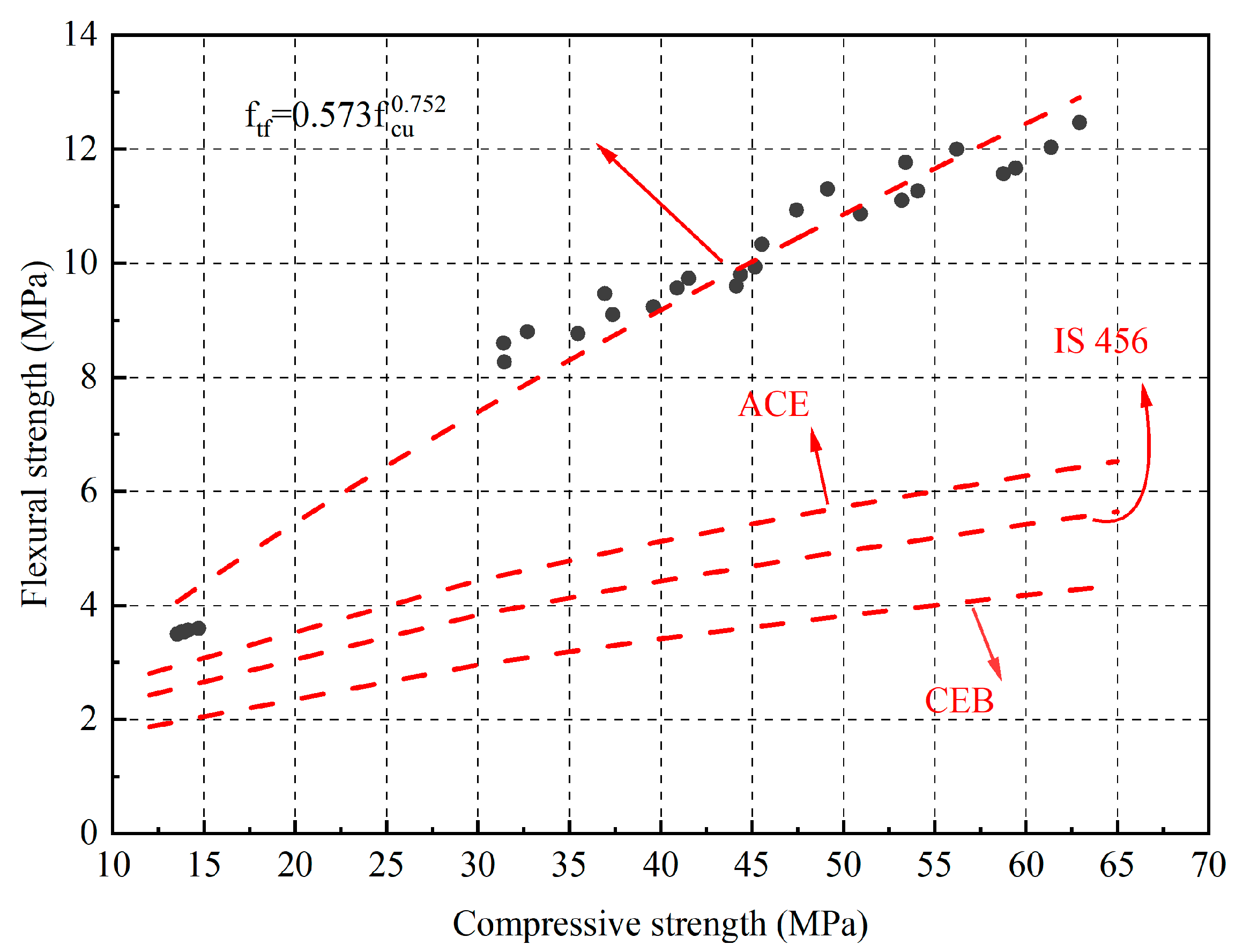
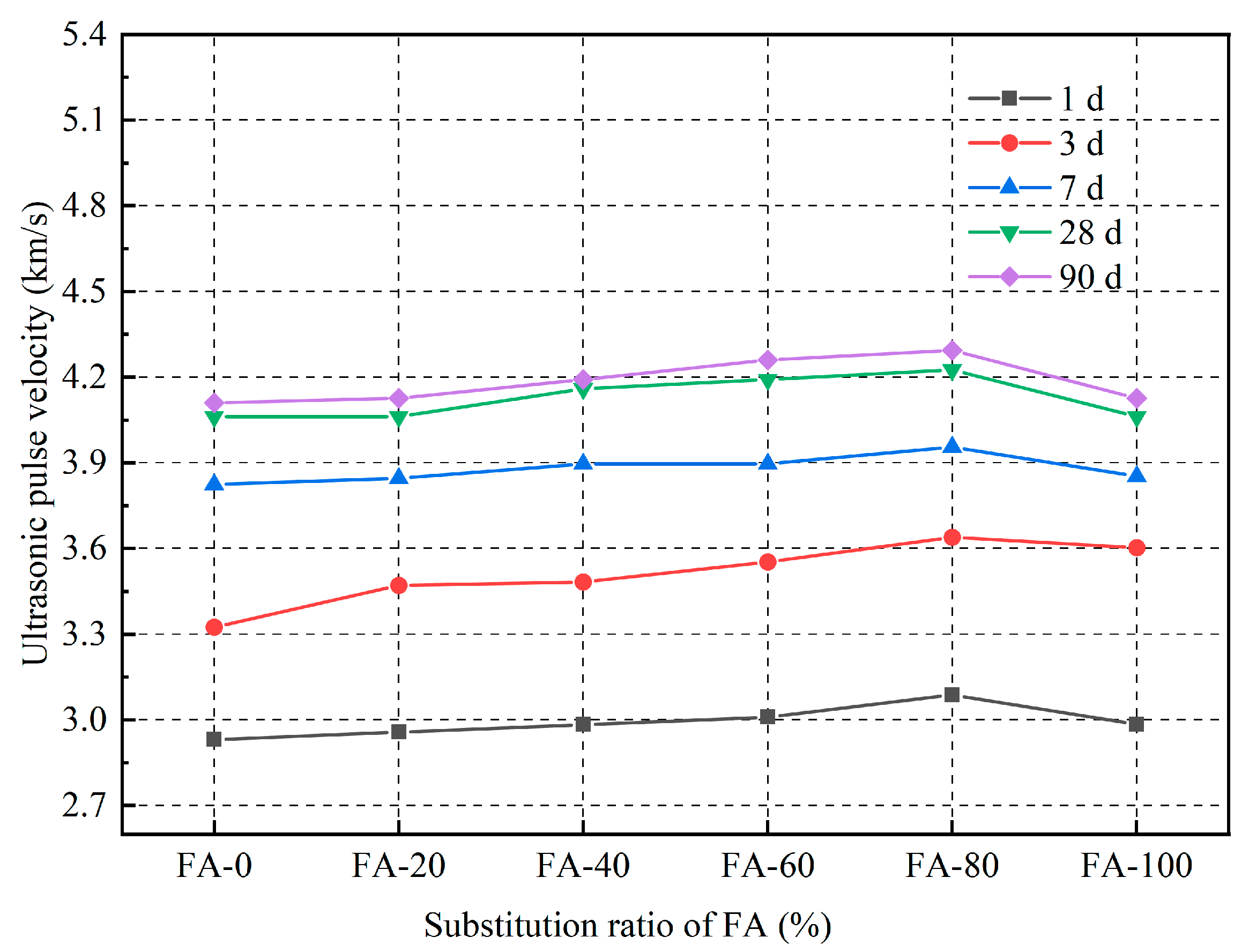
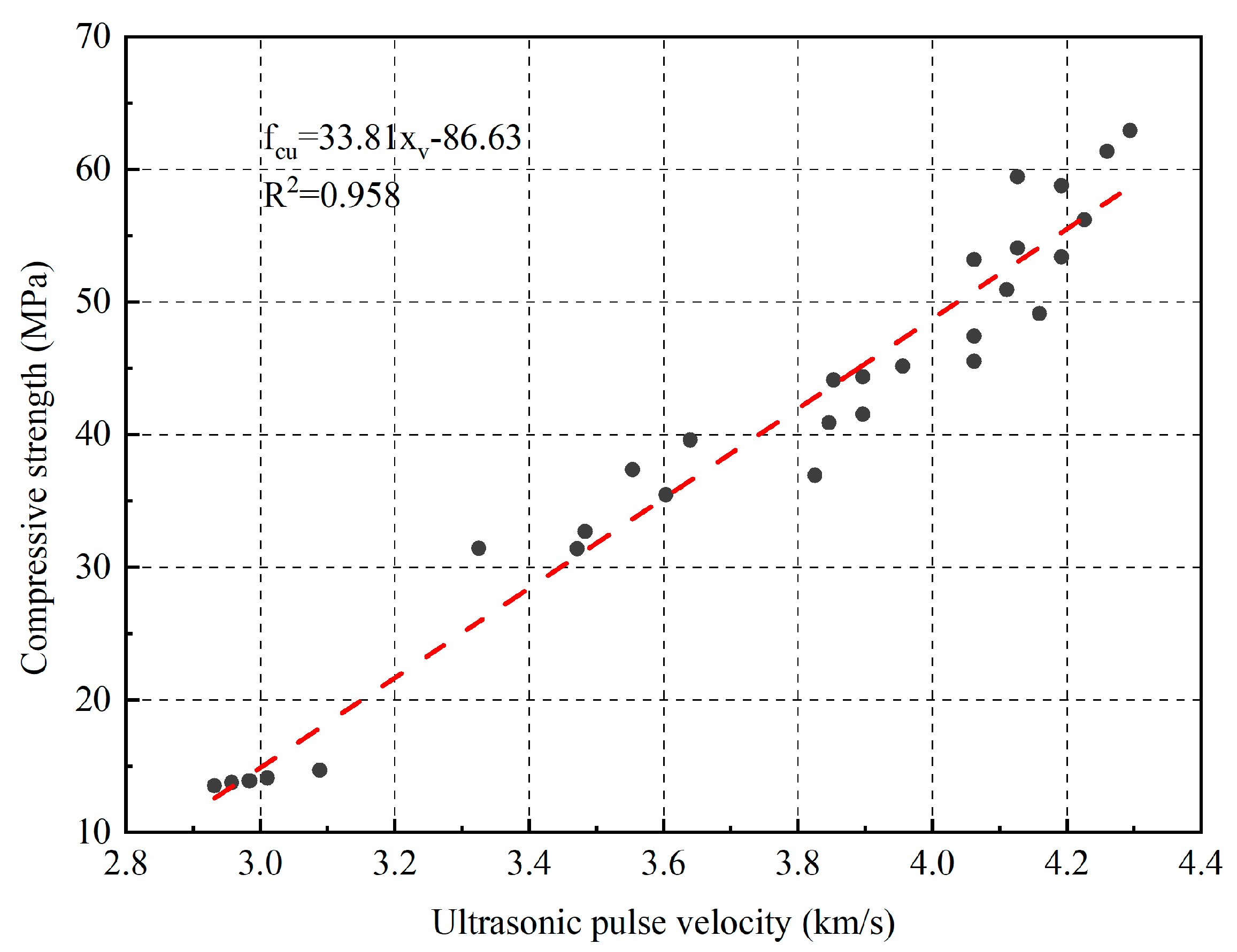
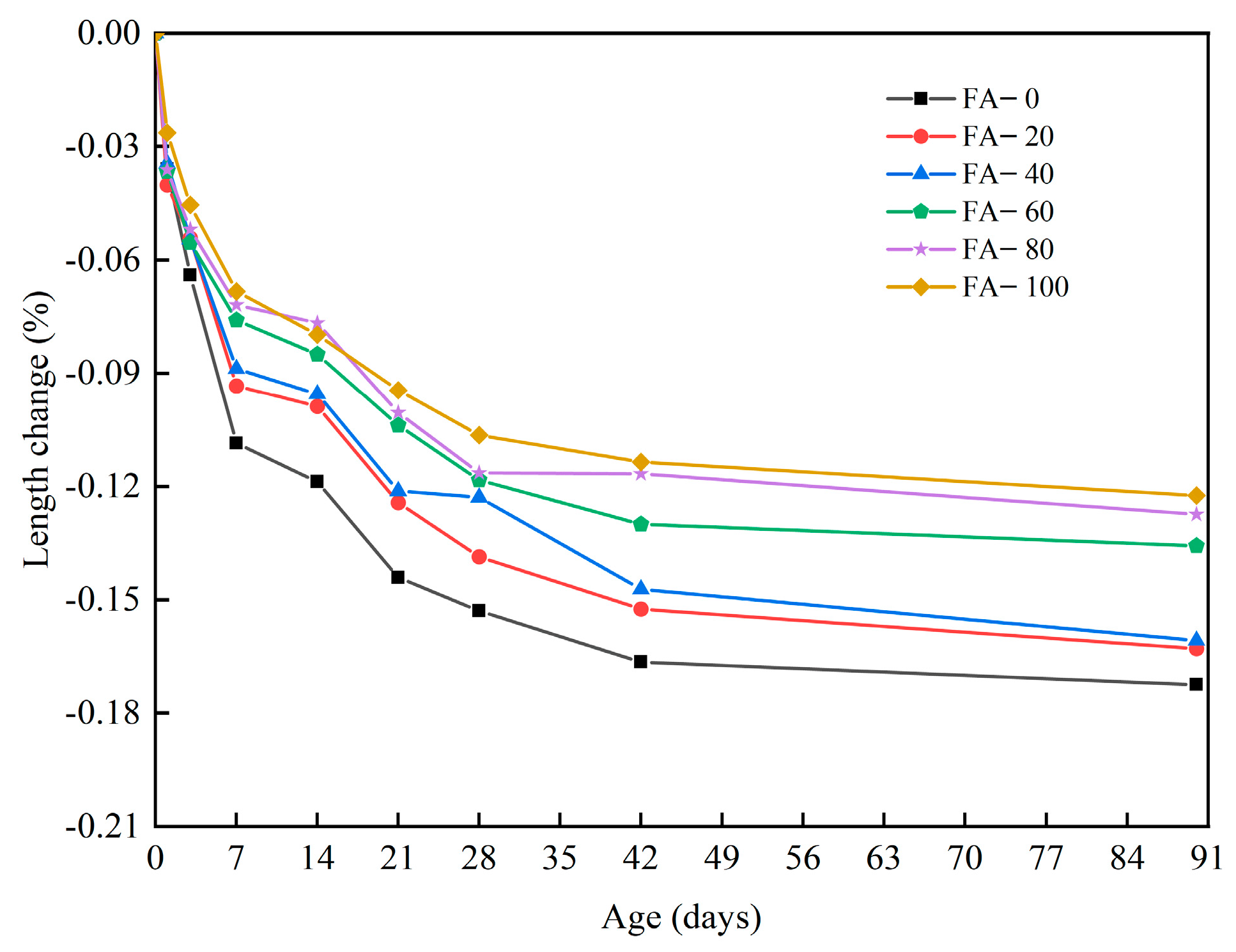
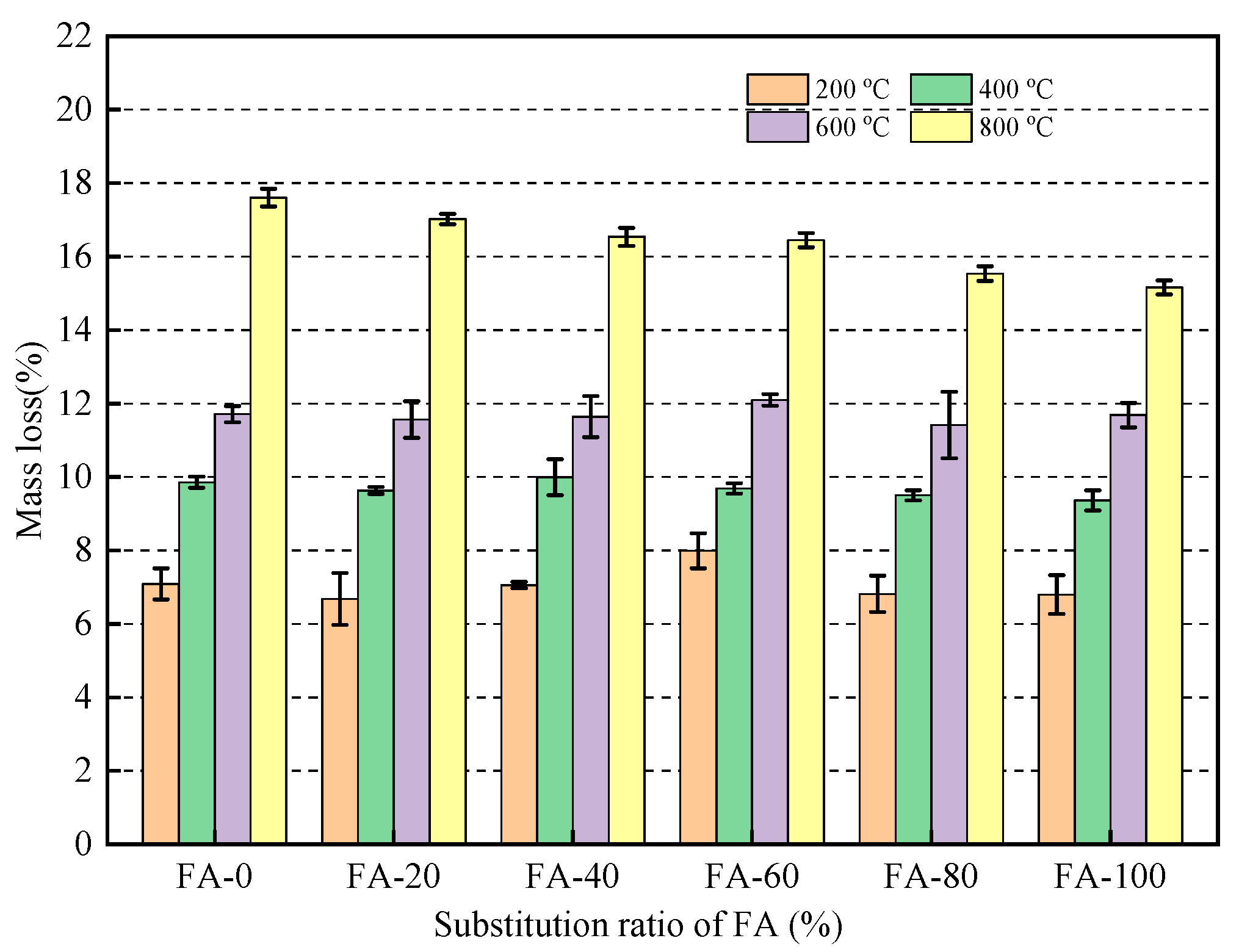
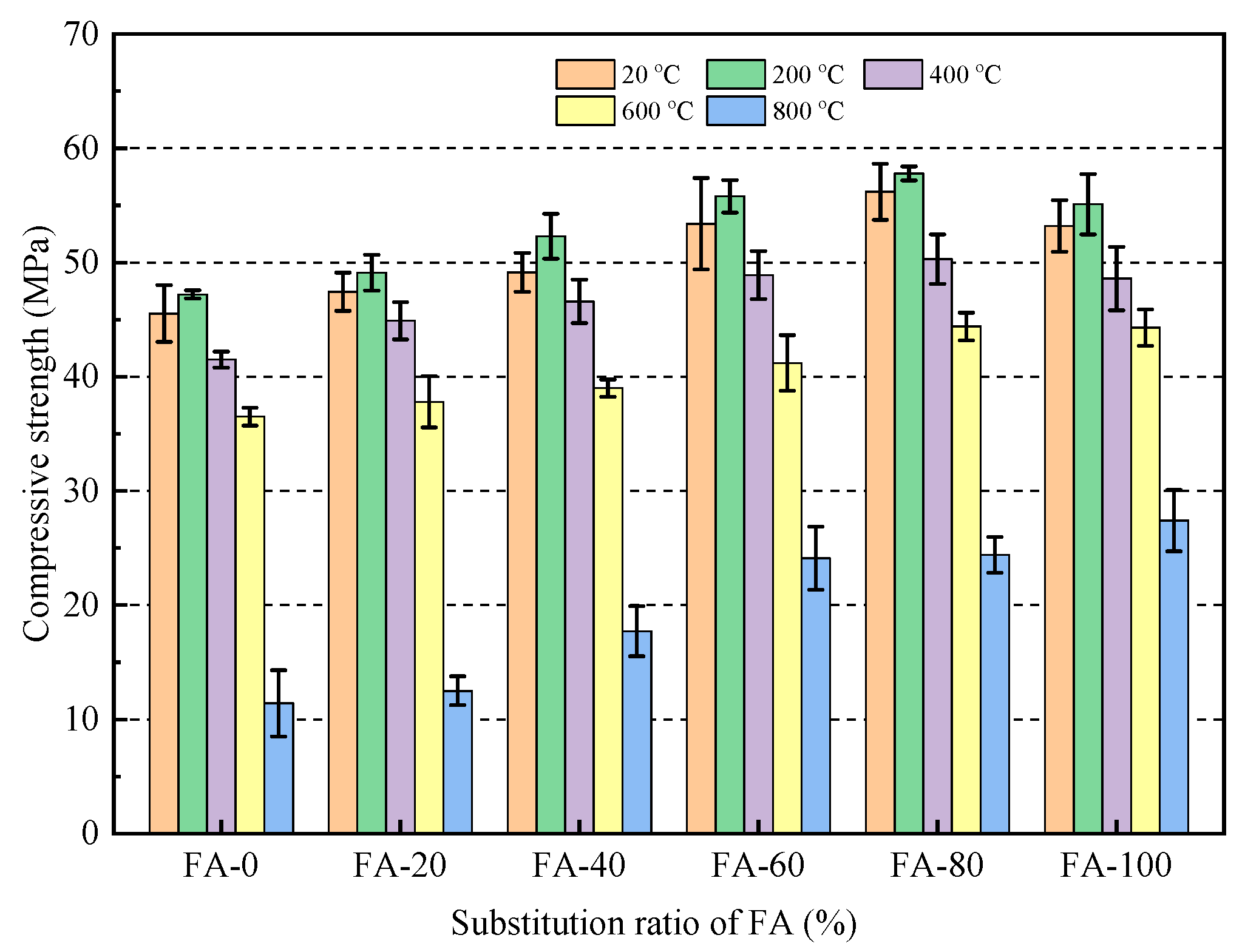
| Chemical Composition | wt% | Physical Properties | Value |
|---|---|---|---|
| SiO2 | 50.35 | Density (g·cm−3) | 2.13 |
| Al2O3 | 29.65 | Water requirement (%) | 97 |
| Fe2O3 | 6.61 | Loss on ignition (%) | 6.3 |
| CaO | 5.85 | 45 μm sieve remaining (wt.%) | 37.1 |
| ZrO2 | 0.11 | ||
| SrO | 0.17 | ||
| MnO | 0.10 | ||
| P2O5 | 1.13 | ||
| TiO2 | 1.75 |
| Content (%) | Water/kg | Cement/kg | Sand/kg | Fly Ash/kg | Superplasticiser/kg | Fluidity/mm |
|---|---|---|---|---|---|---|
| FA-0 | 294 | 700 | 1120 | 0 | 3.3 | 203 |
| FA-20 | 294 | 700 | 896 | 172.5 | 3.7 | 199 |
| FA-40 | 294 | 700 | 672 | 345.1 | 4.3 | 208 |
| FA-60 | 294 | 700 | 448 | 517.6 | 4.7 | 197 |
| FA-80 | 294 | 700 | 224 | 690.2 | 5.1 | 209 |
| FA-100 | 294 | 700 | 0 | 862.7 | 6.4 | 206 |
| Code | 1 d | 3 d | 7 d | 28 d | 90 d |
|---|---|---|---|---|---|
| FA-0 | 101.7 | 100.0 | 100.0 | 100.0 | 100.0 |
| FA-20 | 102.7 | 99.9 | 110.7 | 104.2 | 106.6 |
| FA-40 | 104.4 | 104.0 | 112.5 | 107.9 | 115.4 |
| FA-60 | 108.6 | 118.9 | 120.1 | 117.3 | 120.5 |
| FA-80 | 102.7 | 126.0 | 122.3 | 123.4 | 123.6 |
| FA-100 | 101.7 | 112.8 | 119.5 | 116.8 | 116.7 |
| Code | 1 d | 3 d | 7 d | 28 d | 90 d |
|---|---|---|---|---|---|
| FA-0 | 101.0 | 100.0 | 100.0 | 100.0 | 100.0 |
| FA-20 | 101.0 | 104.0 | 101.1 | 105.8 | 103.7 |
| FA-40 | 101.9 | 106.5 | 102.8 | 109.4 | 106.4 |
| FA-60 | 102.9 | 110.1 | 103.5 | 113.9 | 110.7 |
| FA-80 | 101.0 | 111.7 | 104.9 | 116.1 | 114.7 |
| FA-100 | 101.0 | 106.1 | 101.4 | 107.4 | 107.4 |
| Code | 20 °C | 200 °C | 400 °C | 600 °C | 800 °C |
|---|---|---|---|---|---|
| FA-0 | 100.0 | 100.0 | 100.0 | 100.0 | 100.0 |
| FA-20 | 104.2 | 104.0 | 108.2 | 103.6 | 109.7 |
| FA-40 | 107.9 | 110.8 | 112.3 | 106.7 | 155.3 |
| FA-60 | 117.3 | 118.2 | 117.8 | 112.9 | 211.4 |
| FA-80 | 122.7 | 122.5 | 121.2 | 121.6 | 214.0 |
| FA-100 | 118.3 | 116.7 | 117.1 | 121.4 | 240.4 |
Disclaimer/Publisher’s Note: The statements, opinions and data contained in all publications are solely those of the individual author(s) and contributor(s) and not of MDPI and/or the editor(s). MDPI and/or the editor(s) disclaim responsibility for any injury to people or property resulting from any ideas, methods, instructions or products referred to in the content. |
© 2023 by the authors. Licensee MDPI, Basel, Switzerland. This article is an open access article distributed under the terms and conditions of the Creative Commons Attribution (CC BY) license (https://creativecommons.org/licenses/by/4.0/).
Share and Cite
Zhang, D.; Zhang, S.; Yang, Q. Effect of Replacing Fine Aggregate with Fly Ash on the Performance of Mortar. Materials 2023, 16, 4292. https://doi.org/10.3390/ma16124292
Zhang D, Zhang S, Yang Q. Effect of Replacing Fine Aggregate with Fly Ash on the Performance of Mortar. Materials. 2023; 16(12):4292. https://doi.org/10.3390/ma16124292
Chicago/Turabian StyleZhang, Dongsheng, Shuxiang Zhang, and Qiuning Yang. 2023. "Effect of Replacing Fine Aggregate with Fly Ash on the Performance of Mortar" Materials 16, no. 12: 4292. https://doi.org/10.3390/ma16124292
APA StyleZhang, D., Zhang, S., & Yang, Q. (2023). Effect of Replacing Fine Aggregate with Fly Ash on the Performance of Mortar. Materials, 16(12), 4292. https://doi.org/10.3390/ma16124292








